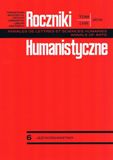"Dąb" jako baza antroponimiczna
"Dąb" as an Anthroponimic Base
Author(s): Władysław MakarskiSubject(s): Language and Literature Studies
Published by: Towarzystwo Naukowe KUL & Katolicki Uniwersytet Lubelski Jana Pawła II
Keywords: structure and meaning of oak-derived names; anthroponymic homonymy; anthroponymic stratigraphy; struktura i znaczenie nazwisk oddębowych; homonimia antroponimiczna; stratygrafia antroponimiczna
Summary/Abstract: This paper analyses over 370 contemporary Polish names based on the appelative dąb (oak). They can be divided into four basic groups of meaning: a) man is characterised as compared to the power of an oak; b) it belongs to a person whose name is derived from an oak; c) someone belongs to a place whose name is derived from an oak; d) a chancellery name ending in –ski derived from an oak. These names, aside to the primary names, are forms by means of suffixes: -ch-, -cz-, -j-, -l-, -ł-, -n-, -ń-, -r-, -s-, -ś-, -sz-, -t-; -a-, -o-; -ów, -owy, -in, -ny; -c-,; -k-; -ic(z); -ski. Sometimes names have a complex form and hybryd with foreign linguistic elements of Russian, German, and Latin. The ambiguity of foundations and multifunctional character of some of their formants results in the phenomenon of homonymy that is present in the anthroponymy under study. Such an anthroponymy, described with regard to its semantic and formal aspect, took shape from the pra-Slavonic times up to the nineteenth century. It is part of the context of floristic anthroponyms and, broader, natural; being its considerable element. This is confirmed by the important role of the oak in the language as a reflection of its meaning in the landscape and in man’s material and spiritual life.
Journal: Roczniki Humanistyczne
- Issue Year: 58/2010
- Issue No: 06
- Page Range: 119-155
- Page Count: 37
- Language: Polish

